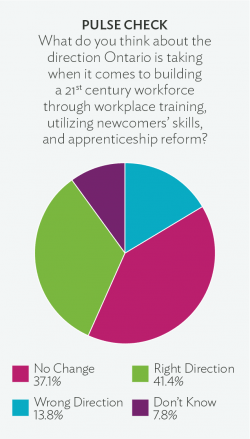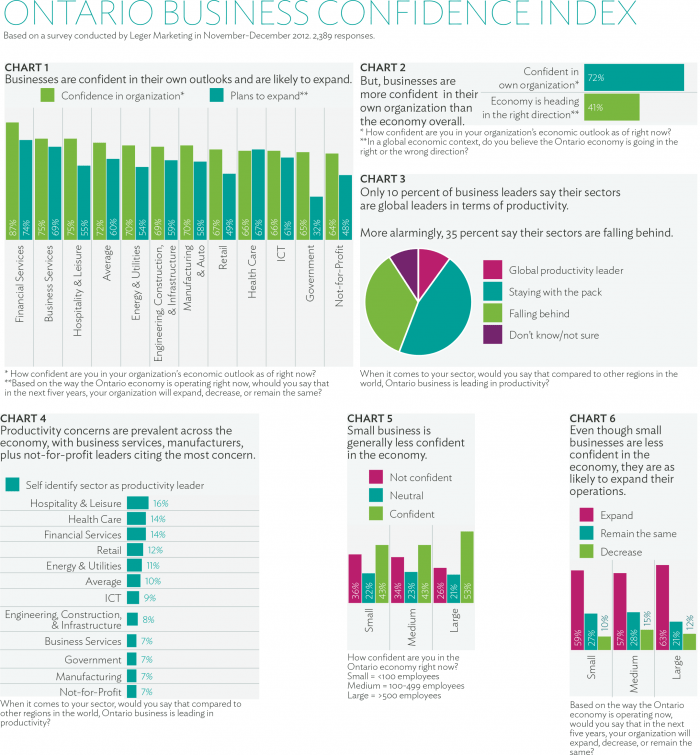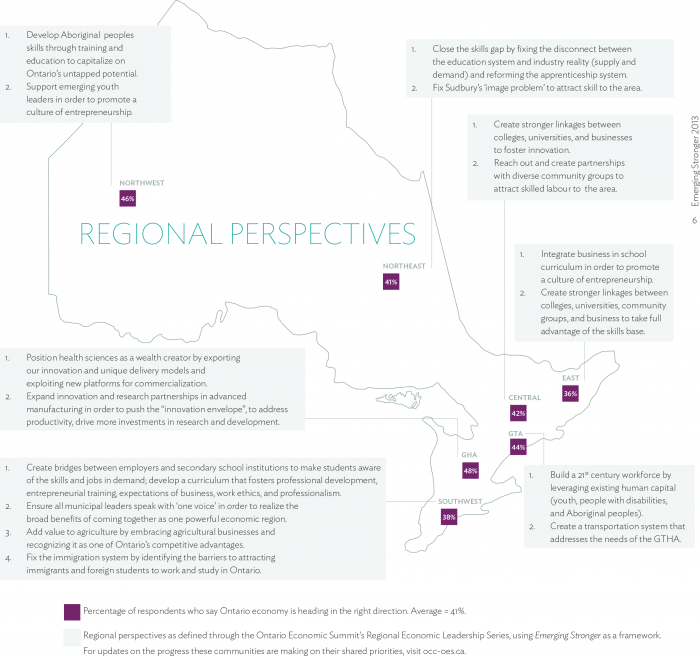Contents
- What the Party Leaders are Saying about Emerging Stronger
- Letter to Ontarians
- Working Together
- The Ontario Business Confidence Index
- Regional Sentiment
- Fostering a culture of innovation and smart risk-taking in order to become a productivity leader
- Building a 21st century workforce through workplace training, utilizing newcomers skills, and apprenticeship reform
- Restoring fiscal balance by improving the way government works
- Taking advantage of new opportunities in the global economy
- Identifying, championing and strategically investing in our competitive advantages in the global economy
- Conclusion
- Summary of Recommendations
- Acknowledgements
WHAT THE PARTY LEADERS ARE SAYING ABOUT Emerging Stronger
Emerging Stronger is a framework for our future shared prosperity. it recognizes that despite the challenges Ontario faces, we are poised to take advantage of opportunities in the global economy and remain the best place in the world to do business and raise a family. like Advantage Ontario, the report of the Jobs and Prosperity council, Emerging Stronger argues that we will succeed, if we tackle our challenges together.
– Premier of Ontario, Dalton McGuinty
Emerging Stronger looks at the problems of today but also looks down the road. it has a real focus on some key economic questions, including an exploration of how we can make Ontario the best place in canada to start a business. i think much of what the Ontario Pcs have talked about can be found in the Emerging Stronger document.
– Leader of the Progressive Conservative Party of Ontario, Tim Hudak
People are the economy. We need innovative solutions now for creating and protecting good-paying jobs so that Ontario families can look to the future with confidence and hope. as Emerging Stronger clearly notes, government has a role to play by helping businesses invest in Ontario workers and equipment. With a strategic focus on research and innovation not only will we meet current industry needs, but we will get ahead of the curve. by investing in people, Ontario can pioneer industries of the future.
– Leader of the New Democratic Party of Ontario, Andrea Horwath
LETTER TO ONTARIANS
It has been one year since the Ontario Chamber of Commerce, the Mowat Centre, and Leger Marketing released Emerging Stronger 2012: A Transformative Agenda for Ontario.
Emerging Stronger 2012 set out an economic agenda for the province that could best be pursued if the federal and provincial governments work together, with the private sector, academia, and labour, to achieve success.
A familiar refrain among concerned Ontarians is that the province faces a clutch moment. Ontario’s finances are faltering under the weight of accumulated deficits. Our provincial debt is approaching $300 billion. Interest payments on that debt now represent the third largest area of provincial spending after health and education, crowding out investments in other programs.
Many sectors that were once Ontario’s strengths are now struggling. More than ever, Ontario’s businesses face stiff competition for investment, markets, and talent.
The Ontario Chamber of Commerce, the Mowat Centre, and Leger Marketing are profoundly confident that Ontario has all the assets it needs to secure its position as the world’s best place to do business, invest, work, and live. But we need to act collectively, strategically, and with purpose. Herein lies the objective of Emerging Stronger 2013.
We have been on an incredible journey since Emerging Stronger 2012 was released. The OCC has criss-crossed the province engaging its 160 local chambers and their 60,000 members, and building our research agendas around it. And the OCC has taken action, including hosting eight regional economic summits across the province, where hundreds of Ontarians identified key economic priorities.
Emerging Stronger 2013 surveys the progress that business, government, and civil society have made over the past year. It identifies the challenges we still face, and sets out the tangible steps we must take to ensure that Ontario emerges stronger from this period of economic transition. We are pleased to report that much progress has been made. However, there is much more to be done.
This is the beginning of a new era for Ontario. The province must embrace a transformative agenda that will challenge Ontarians to meet our huge potential.
We hope that you will join us in moving this agenda forward so that Ontario can emerge stronger, more productive, and more globally connected.
— Ontario Chamber of Commerce & Mowat Centre
WORKING TOGETHER
In 2012, the Ontario Chamber of Commerce (OCC) and the Mowat Centre partnered with Leger Marketing to develop Emerging Stronger 2012: A Transformative Agenda for Ontario. Emerging Stronger 2012 identified five priority areas where Ontario’s business, government, and civic leaders should focus their efforts in transforming the province’s economy:
- Fostering a culture of innovation and smart risk-taking in order to become a productivity leader
- Building a 21st century workforce through workplace training, utilizing newcomers’ skills, and apprenticeship reform
- Restoring fiscal balance by improving the way government works
- Taking advantage of new opportunities in the global economy
- Identifying, championing, and strategically investing in our competitive advantages in the global economy
Since Emerging Stronger was released in January 2012, its message has been met with widespread enthusiasm and support. It has reached every corner of the province and has been supported by the Ontario Chamber Network of over 60,000 businesses and 160 local chambers.
Over the course of 2012, the OCC, the Mowat Centre, and Leger Marketing have taken steps to further this agenda.
The OCC, under the umbrella of its multi-stakeholder Ontario Economic Summit (OES) initiative, hosted eight Regional Economic Leadership Series (RELS) roundtables across the province. Using the five priorities identified in Emerging Stronger 2012 as a lens, the roundtables elicited economic priorities from each region.
The world has changed and we need to change with it. We need bold action… government has a role to play in this, but the business sector must also display leadership.
Gord Nixon, President Royal Bank of Canada, Chair of the Ontario Jobs and Prosperity Council, Speech to the Ontario Economic Summit, November 2012
Together, the priorities identified in the RELS informed the content of the annual meeting of the Ontario Economic Summit (OES) held in Niagara-on-the-Lake in November 2012. The OES convened 220 of Ontario’s top business and civic leaders to carve out an agenda to make the province more competitive. The top priorities identified through the RELS and the OES can be found in this report.
The OCC has also released a research paper, A Federal Agenda for Ontario, which outlines a federal economic strategy for Ontario. Meanwhile, several OCC taskforces are delving further into key parts of the Emerging Stronger vision.
The Mowat Centre has developed a new slate of research projects to further the Emerging Stronger agenda by identifying new opportunities to grow the Ontario economy and connect the province to the rest of the world. These projects explore the future of Ontario’s manufacturing sector, the economic potential of Ontario’s rich diaspora networks, the structure of corporate taxation, and greater cross-border integration in the Great Lakes Region.
In late 2012, Leger Marketing completed the Ontario Business Confidence Index, a survey of 2,400 businesses and organizations from across the province. The results of that survey inform this report. As the largest Canadian-owned polling, research, and strategic marketing firm, Leger Marketing is lending their considerable expertise in public opinion polling to conduct quarterly surveys throughout 2013 on behalf of the OCC.
With cooperation in mind, the OCC and the Mowat Centre offer a follow up to Emerging Stronger 2012. Emerging Stronger 2013 begins with our annual Ontario Business Confidence Index. Then, for each of the five priority areas set out in last year’s report, we assess the progress made, we outline the challenges we face, and finally, we lay out a policy roadmap for the next several years.
Ontario Business Confidence Index
Based on a survey conducted by Leger Marketing in November-December 2012.
Fostering a culture of innovation & smart risk-taking in order to become a productivity leader
In 2012, we noted that Ontario’s innovation gap is a major barrier to increasing productivity and prosperity. This notion has become almost cliché. The province, the federal government, and numerous private sector organizations have undertaken extensive assessments of the innovation and productivity problem.
However, progress has been slow: only 10 percent of Ontario businesses feel their sector is a leader in productivity. Although we are far from a comprehensive set of solutions, we are happy to report significant and meaningful progress.
Progress

Ontario continues to attract foreign investment. According to the Financial Times, Ontario attracted more foreign capital investment in 2011 than any other state or province in North America except Alberta. Ontario ranks first among all major jurisdictions in North America in foreign direct investment (FDI) per capita.
Ontario’s marginal effective tax rate (METR) on new business investment is 16.3 percent—nearly half the average American METR of 31 percent and lower than the average METR of 20 percent among Organization for Economic Cooperation and Development (OECD) countries (Ministry of Finance, 2012). Venture capital supports have been enhanced. The federal government has set aside an additional $100 million and $400 million respectively for the Business Development Bank of Canada and the creation of large-scale venture capital funds. This will encourage more private-sector R&D across the country.
In December 2012, the Government of Ontario’s Jobs and Prosperity Council (JPC) released its final report, Advantage Ontario. It outlines a series of recommendations for improving the province’s long-term productivity and competitiveness. These recommendations, particularly those around procurement, entrepreneurship,
and business supports make a welcome contribution to the policy discussion.
Access to capital for smaller firms is set to grow. The Government of Ontario has recently announced its intention to relax the rules restricting crowdfunding—the practice of pooling investor funds for a charitable or commercial enterprise, usually via the internet. This move will provide startups and small businesses with a new means of accessing capital.
Canadian businesses are starting to invest in productivity. A 2012 poll by the Business Development Bank of Canada found that 56 percent of businesses plan to invest in the coming year, mostly in new machinery and equipment. Surveyed businesses cite boosting productivity and developing new markets as their top reasons for investing.
The Canada Not-for-profit Corporations Act, which came into effect in October 2011, has simplified and dramatically reduced processing times for incorporation applications at the federal level. Ontario’s Not-for-Profit Corporations Act, will do the same at the provincial level starting in 2013.
CHALLENGES
Startup companies require a higher quality and supply of venture capital. business leaders, academia, and government must foster an entrepreneurial culture, one that values risk-taking, and highlights the rewards of entrepreneurship as a career path.
Gord Nixon, Chair, Jobs & Prosperity Council, Speech to Ontario Economic Summit, November 2012
The Ontario Business Confidence Index shows that, relative to their international peers:
- 16 percent view their sector as a leader in innovation
- 10 percent feel their sector is a leader in productivity
- 9 percent see their sector as a leader in re-investment
- 9 percent identify their sector as a leader in research & development
- 8 percent believe their sector is leading when it comes to taking risks
According to some observers, “businesses are simply not being creative 10 enough with the capital and labour they have” (Financial Post, July 3, 2012).
A recent Deloitte study found that “Canadian business leaders [are] 18 % less tolerant of risk than their U.S. peers.” Canadian businesses need to embrace the risk-taking culture of their international competitors.
Our labour productivity growth continues to lag behind that of our U.S. counterparts. Over the last 30 years, U.S. labour productivity growth has outpaced that of Canada by an average of 0.8 percent a year.
According to the JPC, American manufacturers spent $16,000 per employee on non-residential fixed assets in 2011, compared to approximately $9,000 in Ontario. Our own survey of Ontario manufacturers reveals that 42 percent of leaders feel their sector lags behind their international competitors on re-investment.
Both the federal and provincial governments have or are undertaking reviews of their business supports and innovation programming in order to streamline and deliver a greater return on investment. However, businesses are still confronted by a “hodge-podge of direct and indirect programs,” because these efforts are uncoordinated (Commission on the Reform of Ontario’s Public Services).
Next Steps
Direct and indirect supports for r&D should be coordinated at the provincial and federal levels to meet the needs of businesses at all stages of development, including startups. The application process for supports should be simplified and the opportunity cost of seeking assistance minimized. Companies should be allowed to leverage federal funding to receive provincial assistance and vice versa.
Now is the time for Ontario’s business leaders to step
up and take the actions necessary to enhance long-term competitiveness and prosperity.
Roger Martin, Chairman, Task Force on Competitiveness, Productivity and Economic Progress
Governments need to better coordinate their activities and resources to attract large-scale investments in Ontario. The province faces increasingly stiff competition for investment from world-class companies, which are major innovation drivers. Ontario’s ministries, along with their federal counterparts, need a transparent,
coordinated, and systematic process for attracting major investments to the province.
Foster entrepreneurship in the classroom. If we accept that culture accounts for at least part of the explanation for the entrepreneurship gap with the U.S., then we must address it via the education system. This includes building entrepreneurship into high school and university curricula, not just our MBA programs. See the Ryerson University case study below.
Make commercialization part of university mandates. Ontario universities are world leaders in R&D. The problem is that far too little of their work gets commercialized. Previous support programs have not meaningfully closed the commercialization gap. Government must make commercialization part of universities’ mandates.
Leverage public sector procurement to spur innovation. As noted by the JPC, many jurisdictions use public sector procurement to drive the development of innovative products, particularly in growing firms. Ontario should follow suit and implement a strategic procurement policy. This way, companies selling to the public sector could use the public sector buyer as a reference client to drive export sales and gain access to financing. Sectors such as life sciences, manufacturing, and energy would benefit from revamped procurement.
Establish a crowdfunding regime in Ontario. Crowdfunding for financial gain is currently not permitted under Ontario law. With the advent of the JOBS Act in the U.S. and the establishment of an American crowdfunding regime, Ontario must update its legislation and regulations in order to provide its startups and SMEs with comparable levels of access to seed and venture capital. While Ontario has signalled its intention to loosen the rules restricting crowdfunding, it must follow through on that commitment.
We should teach students how to create jobs, rather than how to have a job.
John Tory, Chair of Civic Action, Ontario Economic Summit, 2012
Ontario businesses need to invest in the levers of productivity. Perhaps most worrying is the Ontario-U.S. Information and Communications Technology (ITC) investment gap, which currently stands at 32 percent.
Open up public data. The provincial government and municipalities sit on a treasure trove of data that could be repurposed by entrepreneurs and technology firms to create valuable software applications and other innovations for commercial purposes. As of January 2013, the Ontario government’s open data portal holds just 65 data sets.
Allow colleges to play a bigger role in driving innovation. Colleges are key players in the commercialization process. They must be given the freedom to allocate their existing funds and resources, specifically faculty, in a manner that responds to local innovation imperatives.
Improve transparency in regulation. Ontario is one of the few jurisdictions in the world that does not publish the rationale for, and the cost-benefit analyses of regulations. The only requirement is to publish the content of regulations. Public servants need incentives to consult internal and external stakeholders and “get it right the first time.”
Address the cumulative regulatory burden on businesses. The government should introduce an ongoing process for monitoring the “web of rules” that builds upon the burden reduction exercise led by Open for Business from 2008 to 2011. The cumulative regulatory burden on business should be reduced to improve Ontario’s business climate.
Ontario should pursue a simplified tax system. Ontario must ensure that its tax system makes it the most attractive destination for business investment and development in the OECD. Corporate taxation reforms must improve both the efficiency and effectiveness of corporate taxation.
Ontario should continue to push for a common Securities regulator. Canada is the world’s only major industrialized country without a single securities regulator. A single securities regulator would increase access to capital and would also solidify Toronto’s position as a major global financial centre.
 CASE STUDY: COMMERCIALIZING RESEARCH
CASE STUDY: COMMERCIALIZING RESEARCH
University of Toronto’s Banting and Best Centre for Innovation and Entrepreneurship
The problem: Too many professors and students have to leave the “innovation ecosystem” (the environment in which the discovery was made) to commercialize their inventions, thereby losing access to students, academics, and laboratories.
A solution: Using surplus space, the University of Toronto created the Banting and Best Centre for Innovation and Entrepreneurship to develop early-stage enterprises and spin-off companies to commercialize academic discoveries.
Tenants pay market rents but benefit from in-house cross-pollination in marketing and business know-how while maintaining access to nearby labs and students.
The results to date: Companies inside the thriving Banting and Best Centre for Innovation and Entrepreneurship have created 79 jobs (all private sector) and have raised a total of $22.8 million in private and public sector investments.
 CASE STUDY: CREATING A CULTURE OF ENTREPRENEURSHIP
CASE STUDY: CREATING A CULTURE OF ENTREPRENEURSHIP
Ryerson University’s “Entrepreneurial Zone”
The problem: Too many students are leaving university without business acumen and the knowledge to start a business and/or commercialize their innovative ideas. Ontario firms consistently cite a lack of business and real-world skills as a significant impediment to growth.
A solution: Ryerson University uses an “entrepreneurial zone” model in fields in which it is already an established educational leader. Within the next two years, Ryerson plans to add entrepreneurial zones in fields such as: Aerospace, Design, Health, and Social Entrepreneurship. The aim is to have 10 percent of all Ryerson students involved in the development of a company, product, or service by the time they graduate.
The results to date: Since Ryerson’s highly successful Digital Media Zone opened in April 2010, 62 cutting-edge startups have been incubated and accelerated and 620 jobs have been created through startups and market-driven research. We can expect similar results from future entrepreneurial zones.
BUILDING A 21ST CENTURY WORKFORCE THROUGH WORKPLACE TRAINING, UTILIZING NEWCOMERS’ SKILLS, & APPRENTICESHIP REFORM
Ontario suffers from a paradoxical challenge. Rates of unemployment and underemployment are high. At the same time, Ontario faces massive labour and skills shortages in key sectors. The Conference Board of Canada predicts that if unaddressed, Ontario’s skills gap could reach 560,000 by 2030 (Conference Board of Canada, 2007).
The mismatch between supply and demand continues to be a significant barrier to Ontario’s economic transformation.
PROGRESS

Reforming Canada’s Employment Insurance (EI) system was identified as a priority in last year’s Emerging Stronger agenda. The Mowat Centre has been a leading voice in the campaign to remove barriers to labour market retraining for underemployed Canadians. As recommended by the Mowat Centre EI Task Force, the federal government has eliminated the so-called “Best 14 Weeks” pilot project, which caused premiums on Ontario workers and businesses to be unnecessarily high while providing Ontarians with lower EI benefits than workers elsewhere in Canada.
Ontario’s Expert Roundtable on Immigration identified a path forward for the province’s immigration system, emphasizing the need for Ontario to use the system to plug skills gaps in its labour force.
The federal government is moving ahead with an Expression of Interest (EOI) model and is in the process of allocating provincial quotas for skilled labour. An EOI model is designed to better connect immigrants with employment opportunities and plug labour market gaps. Ontario, along with other provinces, has expressed support for the federal government’s EOI concept and has asked the federal government to work with the province in the design of the new approach.
The federal government has also expanded the Canadian Experience Class (CEC) program, which facilitates the transition from temporary to permanent residence for those with high-skilled experience in Canada, including international students and temporary foreign workers. Admissions under the CEC have increased from about 2,500 people in 2009 to more than 6,000 in 2011. In 2013, the federal government will accept up to 10,000 permanent residents through the program.
The province has renewed the Second Career retraining program’s mandate for 2012-13, to the tune of $251 million. This will serve 12,000 workers. Second Career has benefited 55,000 workers to date.
CHALLENGES
Our Ontario Business Confidence Index results show that 41 percent of Ontario business leaders believe the province is heading in the right direction in terms of building a 21st century workforce through workplace training, utilizing newcomers’ skills, and apprenticeship reform.
The federal government has implemented changes to the EI program that will address some of its distortionary labour market incentives, but structural inequities continue. Overall, the program remains a barrier to building a 21st century workforce in Ontario.
The single largest pool of funding for worker training in Canada is linked to the EI program. Because Ontario has a comparatively low percentage of EI-eligible workers, the province is significantly short-changed on federal training dollars, to the tune of almost $300 million a year.
The number of economic immigrants to the province—those selected on the basis of their skills or employment prospects—has declined severely over the last decade, from 89,079 in 2001 to 36,939 in 2011. Ontario employers are very concerned.
As the final report by the Commission on the Reform of Ontario’s Public Services (also known as the Drummond Commission) noted, employment and training programs are “not strategically organized nor consistently evaluated against labour- market success factors, clear targets or performance measures linked to outcomes.” The return on taxpayer investment in training is not adequately transparent.
More than half of on-reserve First Nations between the ages of 25-34 have not finished high school, compared with only 10 percent of Canada’s overall population in that age group. The employment rate for Aboriginal peoples is 65.8 percent, well below the employment rate for the non-Aboriginal population.
Aboriginal youth are Canada’s fastest-growing demographic, growing 45 percent between 1996 and 2006. An estimated 600,000 Aboriginal youth will reach working age between 2001 and 2026.
About 1.9 million people in Ontario, or 15.5 percent of the population, live with a disability. The unemployment rate among people with disabilities with post-secondary education is 3 to 4 percentage points higher than the national average. Evidence suggests that employer misperceptions are a major reason for this discrepancy.
NEXT STEPS
The federal government should implement the recommendations of the Mowat Centre EI Task Force, including reforms to eliminate the regional discrepancies in coverage and to delink training funding from EI and instead fund training through general revenue. This would make available significant new funds in Ontario for training workers who are currently not on EI, whether they are under-employed, looking to enhance their skills, concerned about the future of their sector, or have been out of the labour market.
Implement the recommendations of Ontario’s expert roundtable on Immigration. To fill its skills gaps and increase its human capital, at a minimum Ontario needs to boost its level of immigration to 135,000 people per year (the equivalent of 1 percent of its population), a significant increase from the 99,000 immigrants Ontario received in 2011. Sixty-five to seventy percent of these immigrants should be economic class immigrants, an increase of 25-30 percent from current levels. The focus of immigration policy should be on building the province’s human capital.
Businesses need to take better advantage of existing opportunities, such as the Provincial Nominee Program, to win the “global war for talent.” They should also develop explicit strategies, such as Kitchener-Waterloo’s Immigration Partnership Council, aimed at integrating immigrants and refugees into the workplace and taking better advantage of credentials and experience gained internationally.
Ontario and the federal government should collaborate in the design and implementation of an expression of Interest (EOI) immigration model. An EOI model would allow employers to select from a pool of pre-screened immigration applications. This is a promising opportunity to enhance the flexibility, responsiveness, and speed of economic immigration to Canada, with the potential to focus on top talent and human capital. By collaborating in the design of the EOI, the Ontario government will have greater influence on the selection of immigrants.
Ontario’s universities and colleges should expand recruitment initiatives aimed at international students. Furthermore, post-secondary institutions should promote the Canadian Experience Class program to all foreign students without a job offer to transition to permanent resident status. This may require more on-campus settlement and integration services for international students.
Ontario businesses must capitalize on the untapped potential of Ontario’s aboriginal population. The Aboriginal population is the fastest growing in Canada. Businesses can engage aboriginal students through work placements and co-op programs. See Imperial Oil Case Study below.
The federal government must close the funding gap for on-reserve aboriginal education. It is generally accepted that federal funding for Aboriginal education falls significantly short of parity with provincial education spending on a per-student basis. Creating a leading-edge workforce requires the full participation of Aboriginal peoples in the labour market. Full participation is contingent on providing opportunity through adequately funded, outcomes-focused, and culturally appropriate education.
Ontario needs to reinvent its employment and training services. Ontario should invite competition and greater employer participation into employment and training services. Private sector and not-for-profit participation in training supports should be commissioned on a “payment by results” basis.
Employers need to recognize the potential of people with disabilities. The OCC and its members will work together to leverage the strong potential of this group and actively combat negative perceptions.
Ontario’s apprenticeship system needs to become more flexible. Ontario’s skills gap can be narrowed by reforming the province’s outdated journeyperson to apprenticeship ratios. By bringing the ratio across all trades as close to 1:1 as soon as feasible, Ontario will join the majority of Canadian provinces that have already taken this step.
 CASE STUDY: TAPPING INTO THE POTENTIAL OF ONTARIO’S ABORIGINAL PEOPLES
CASE STUDY: TAPPING INTO THE POTENTIAL OF ONTARIO’S ABORIGINAL PEOPLES
The SEED program was created by Imperial Oil and Six Nations of the Grand River Territory
The problem: Employers face increasing skills shortages in key sectors. Yet Ontario’s Aboriginal employment rate is far below that of the non-Aboriginal population.
A solution: Imperial Oil has shown an eagerness to tap into the potential of Ontario’s Aboriginal peoples while closing the Aboriginal education attainment gap in the process. In 2003, the Science Education and Employment Development (SEED) program was created by Imperial Oil and Six Nations of the Grand River Territory. The 21 agreement supports technology education and employment initiatives focused on providing people with skills required for careers with Imperial, the petroleum industry, and other manufacturing industries.
The results: Since 2002, SEED has invested over $2 million in education and skills training related initiatives, including:
- the Native Diploma Access Program which allows mature students to earn eight high school credits towards their grade 12 diploma—with a focus on math and science. Since 2005, students have completed more than 275 high school credits;
- the Bridging Our World Through Science Program, which brings students from grades 10 and 11 to Brock University for a two-day Aboriginal Outreach program. Participants learn about career options in the science fields. Post-camp surveys show that more than half of the students indicated this program increased their interest in pursuing post-secondary education.
 CASE STUDY: BRIDGING THE SKILLS GAP
CASE STUDY: BRIDGING THE SKILLS GAP
Bombardier and Centennial College have a Memorandum of Understanding to train employees and upgrade skills
The problem: Ontario’s aerospace sector faces a current and growing shortfall of skilled employees. As Ontario’s biggest aerospace employer, Bombardier has 4,000 employees and depends on skills upgrading in order to stay at the cutting edge of lean, efficient production processes. The average employee age at Bombardier’s Downsview Aerospace Facility is 54, and Bombardier will have to replace hundreds of workers in the coming years.
A solution: Direct partnerships between employers and post-secondary institutions designed to integrate the classroom into the workplace and allow students to upgrade their skills in real time.
Results to date: Bombardier and Centennial College have a Memorandum of Understanding whereby Centennial College will train Bombardier employees in 12 to 16-week programs over the next two years. A full training curriculum has been jointly developed. Bombardier has invested approximately $2 million in an on- site Learning Centre at its Downsview facility, where the company manufactures business and commercial aircraft.
RESTORING FISCAL BALANCE BY IMPROVING THE WAY GOVERNMENT WORKS
Last year we identified sound fiscal strategies—balanced budgets, reasonable taxation, and efficient public services—as being critical to Ontario’s future prosperity.
Some progress has been made towards reducing the province’s deficit. But the need for fiscal and public sector reforms remains. We must continue to identify new ways of delivering better services at less cost and seek a fairer deal for Ontarians from the federal government.
PROGRESS

The 2012 Ontario Budget committed Ontario to an annual average growth in program spending of 1 percent between 2011–12 and 2014–15—a significant reduction in real-term expenditure.
Getting the provincial health care budget under control is critical to eliminating the deficit. The Ontario government is moving toward a patient-centred funding model in the health care system. Under this approach, hospitals and other health facilities will be funded based on the types and volume of services and treatments they deliver. This will encourage efficiency in the health system.
The government has also indicated it will shift routine health procedures currently conducted in hospitals to non-for-profit, community-based clinics where they can be performed faster, at lower cost, while maintaining quality.
The fee schedule for physicians has been adjusted to reflect changes in medical technologies, as recommended in the Mowat Centre’s Shifting Gears series. These adjustments are expected to save taxpayers $338 million a year.
CHALLENGES
Ontario’s deficit is $11.9 billion and its provincial debt is approaching $300 billion, which is over $22,000 per man, woman and child.
Ontario’s debt to GDP ratio will hit 42 percent in 2015-16; its debt to GDP ratio has more than tripled since 1990.
In April 2012, Ontario’s credit rating was downgraded by Moody’s in response to a rising debt burden and slow economic growth outlook. A 1 percent increase in the cost of borrowing will crowd out another $500 million in annual program spending.
The federal transfer system continues to disadvantage Canada’s most populous province. In spite of Ontario’s fiscal woes, Ontarians pay roughly $12.3 billion more into the federation than they get back.
Ontario’s per capita program spending is already the lowest of any province, at $8,560 in 2011-12, which is 11 percent below the provincial average.
The reality is that little progress has been made this year on introducing greater parity in federal fiscal transfers. The federal government announced in December 2012 that the Equalization program will not be re-adjusted in response to Ontario’s concerns. In fact, the technical changes to the program announced by the federal government are likely to cost Ontario about $100 million per year.
Infrastructure is critical to Ontario’s competitiveness. According to a 2012 OCC survey of its membership, after deficit and red tape reduction, the number one public policy priority for business is infrastructure renewal. However, all of Ontario’s infrastructure budget will be absorbed by amortization costs by 2017.
NEXT STEPS
The private and not-for-profit sectors should play a bigger role in delivering public services. While Ontario routinely partners with the private sector on capital projects, there is ample opportunity to seek new partnerships for service delivery, particularly in those areas where private and not-for-profit expertise already exists (e.g. health care, skills training, insurance, and information technology support). Alternative service delivery should always be considered when it can achieve cost-savings without compromising the quality of the service in question.
The private and public sectors must do their part to help Ontario get back to fiscal balance. For businesses, this means accepting a delay in scheduled business and corporate tax rate reductions and the end of certain business support programs. For the broader public sector, this means recognizing that compensation restraint is needed to control rising labour costs.
Streamline public sector procurement. The Ontario government should conduct a “lean assessment” of its procurement processes, identifying elements than can be streamlined or eliminated to increase efficiency and make it easier for SMEs to participate. Both suppliers and government would benefit from faster turnaround times and less resource-intensive procedures. This type of review has been successfully undertaken by the UK’s Cabinet Office.
Close the $12.3 billion gap. Because of the unprincipled nature of Canadian federal fiscal arrangements and funding agreements, Ontarians and Ontario businesses are often short-changed. The federal government needs to reform Equalization and create a national standard for EI access, and fix the funding gaps in infrastructure, training, housing, and regional economic development funds.
Tackle the underground economy to increase revenue. The underground economy makes it hard for legitimate businesses to compete. Ontario needs tougher penalties for noncompliance and a stronger focus on high-risk industries. The Drummond Commission estimates that these and other compliance measures could yield over $500 million per year for the province. The Drummond Commission also notes that many fines valued at $1 billion under the Provincial Offences Act (POA) remain uncollected. The province should take more aggressive action to collect this money.
Develop an asset management framework. The Ontario Ministry of Finance put the value of provincial public assets at $138 billion in 2011. Public discussion on how government should best manage its assets often centres on the choice between public ownership and privatization. A new asset management framework should be developed that includes the full range of options available for the management of public assets and looks to protect the public interest while increasing revenues. The Mowat Centre will be releasing a report outlining opportunities on this front in spring 2013.
Engage Ontarians in a discussion on how we pay for our infrastructure. The government simply does not have the resources to fund large infrastructure projects through general revenues. While engaging the private sector in partnerships can
fill funding gaps, major projects require additional sources of revenue. The Big Move, Ontario’s transportation plan for the Greater Toronto and Hamilton Region, is an opportunity to engage all stakeholders in a dialogue on revenue tools.
Unleash private capital for public good. Ontario and Canada have made enormous investments in our infrastructure throughout our history. These projects, including the St. Lawrence Seaway, railways, public transit, and our highway system, all created the foundation for the prosperity and quality of life we enjoy today. There will not be the same volume of public funds available in the coming decade to reinvest in the modernization of our infrastructure. However, new and established vehicles—from bonds and P3s to leasing and concession agreements—liberate private funds for public purposes. These must be used more frequently and rigorously.
 CASE STUDY: INNOVATION THROUGH SPECIALIZATION
CASE STUDY: INNOVATION THROUGH SPECIALIZATION
By focusing on a routine procedure, Kensington’s Eye Institute has developed a specialization that has lowered cost per procedure and increased patient volume
The problem: Health care costs are consuming an increasing percentage of the provincial budget, crowding out spending in other areas.
A solution: Kensington Health is a group of not-for-profits and charities that delivers a variety of health services in Toronto. Kensington Health delivers publicly funded health services outside of the hospital setting.
The results to date: By focusing on a routine procedure, Kensington’s Eye Institute has 29 developed a specialization that has lowered cost per procedure and increased patient volume. The Eye Institute performed nearly 7,500 cataract surgeries in 2011 and
8,400 in 2012 while adding glaucoma surgeries, cornea transplants, and non-urgent vitreoretinal services.
“By focusing on a select few procedures, they [Kensington Eye Institute] can serve more patients more quickly with excellent patient outcomes.’
Ontario Health Minister Deb Matthews,
Kensington Eye Institute 2011-12 Year In Review
 CASE STUDY: FOCUSING ON OUTCOMES, NOT PROCESS
CASE STUDY: FOCUSING ON OUTCOMES, NOT PROCESS
The opportunities for private sector involvement in Ontario service delivery are numerous and extend well beyond health insurance
The problem: The recent economic downturn has left governments across the globe cash strapped. Yet citizens’ expectations with regard to services have not diminished. Governments need to find new service delivery and back office models that improve service and lower overall cost.
A solution: Performance-based contracting is emerging as a powerful solution for governments seeking to manage costs while enhancing service quality. In 2004, British Columbia selected MAXIMUS Canada to administer the provincial medical and drug benefits programs (Health Insurance BC) including the people, process, and technologies. BC’s decision to use a private operator was spurred by service challenges and a lack of capital to invest in new technologies.
The results to date: Since 2005, MAXIMUS has met all 27 new service level requirements (for business, technology, and privacy) for Health Insurance BC. For example, all calls from citizens and providers are answered within specified time frames whereas prior to handover to MAXIMUS, more than 50 percent of calls encountered a busy signal. Furthermore, the contract requires MAXIMUS to make significant capital investments to replace aging technology supporting the two programs, investments that the province retains ownership of at the conclusion of the contract.
TAKING ADVANTAGE OF NEW OPPORTUNITIES IN THE GLOBAL ECONOMY
Ontario’s economic prospects have always been tied to trade. Markets in the U.S., and particularly Great Lakes states, remain vitally important to the Ontario economy. But more must be done to diversify the province’s export markets. Aside from North America, our Ontario Business Confidence Index respondents identified China and India as the most important export markets.
Ontario is the destination of choice for almost half of new immigrants to Canada. The province must leverage the links to trade and investment opportunities that its immigrant communities offer.
PROGRESS

Canada has continued to move forward with trade liberalization. Since 2006, Canada has concluded new free trade agreements with nine countries: Colombia, Jordan, Panama, Peru, the European Free Trade Association (Iceland, Liechtenstein, Norway and Switzerland), and Honduras. Canada is working towards a free trade agreement with the European Union and is seeking membership in the Trans-Pacific Partnership.
Progress has also been made in Canada-U.S. economic relations. The Regulatory Cooperation Council is working to harmonize cross-border regulation, which is good news for southern Ontario’s Great Lakes trade corridor.
The construction of the Detroit River International Crossing (DRIC) has been approved and it appears the major obstacles to its construction have been cleared. The DRIC will help Ontario accommodate the expected doubling of Canada-U.S. trade flows over the next 30 years.
The Mowat Centre has begun a research project that will develop policy recommendations for tapping into the huge economic potential of Ontario’s diversity. The province has extensive diaspora networks that connect it to world markets and, most importantly, emerging economies like China and India.
The Ontario government is acting on a JPC recommendation and establishing new Global Exporter Forums. The Global Exporter Forums should help Ontario businesses expand into international markets. The forums are designed to increase export activity among Ontario businesses by building awareness of opportunities in emerging markets. The first Global Exporter Forum will highlight the Asia Pacific region, including markets in China and India.
CHALLENGES
Ontario businesses view China and the Great Lakes states as the most critical markets in the next 5-10 years. Fifty-one percent of Ontario Business Confidence Index respondents identify Great Lakes states as the most important while 45 percent chose China.
In spite of the importance Ontario businesses attribute to trade diversification, Ontario’s exports are far from diverse. Close to 80 percent of Ontario’s exports are destined for the U.S. Less than 2 percent are bound for India (0.3 percent) and China (1.4 percent). Compare that to Michigan, whose exports to China now make up 5.3 percent of their total exports.
Ontario has robust networks of immigrants with ties to emerging economies. Between 2004 and 2008, 16.8 percent of all landed immigrants to Ontario came from India, with a further 13.4 percent arriving from China. The province has yet to take advantage of the unique trade opportunities that these networks provide.
The OCC’s Global Growth Fund can serve as a model for collaboration between the government and a
not-for-profit organization. The Fund has helped over 650 businesses access export markets and collectively these companies have reported export sales in excess of $125 million.
Ontario’s small Business enterprise Centres should be twinned with their U.S. counterparts in key cities in the Great Lakes Region. We need to find new ways of lowering the information and search costs for Ontario SMEs wishing to export to the U.S. Both the Ontario and U.S. federal governments offer assistance to SMEs through a network of local small business centres. Cross-border partnerships between these centres should help boost the proportion of Ontario SMEs involved in export activities.
Ontario businesses are simply not sufficiently engaged in trade. According to the JPC, only 7 percent of Ontario SMEs are engaged in export activities. The average value of Ontario SMEs’ exports ranks below that of 47 of 50 U.S. states.
Ontario’s transportation network is a major part of the province’s infrastructure and a significant enabler of trade and economic investment. However, the transportation network is badly in need of upgrading. Congestion in the Greater Toronto and Hamilton Area alone costs an estimated $6 billion a year. Renewing Ontario’s transportation network is critical if Ontario is to improve its competitiveness in the decades to come.
NEXT STEPS
Ontario needs to develop an export growth strategy focused on SMEs. Fewer than 1 in 10 SMEs export. Programs that connect SMEs to new markets should be expanded when value for money can be demonstrated.
Create a one-window access point for businesses seeking export assistance. SMEs face high search costs associated with obtaining information and access to export programs, financing, and intermediaries abroad. Government and service providers across the spectrum will benefit from a one-window approach that pools resources and supports, enhancing the financial viability of exporting for SMEs.
Ontario must diversify its trade and leverage its diaspora connections to emerging markets. The Mowat Centre’s ongoing research on diaspora networks will identify specific policy tools that the province can use to leverage its immigrant communities’ ties to global markets. The Ontario Chamber Network is well positioned to play a leading role in connecting businesses both here and abroad.
Remove inter-provincial trade barriers. Ontario’s ability to trade with its provincial cousins is hindered by complex regulatory obstacles. Provinces should continue progress on eliminating inter-provincial trade barriers as a means of diversifying their trade partners.
 CASE STUDY: ONTARIO’S AGRI-FOOD INDUSTRY: READY TO RESPOND TO GROWING GLOBAL FOOD DEMAND
CASE STUDY: ONTARIO’S AGRI-FOOD INDUSTRY: READY TO RESPOND TO GROWING GLOBAL FOOD DEMAND
Ontario’s agri-food industry contributes $33 billion to the Ontario economy and employs roughly 745,000 people
The potential: Few Ontarians realize the fundamental role that the agri-food industry plays in the province’s economy. Ontario’s agri-food industry contributes $33 billion to the Ontario economy and employs 745,000 people (Ministry of Agriculture, Food, and Rural Affairs, 2009), roughly 11 percent of total Ontario employment. Ontario’s agri-food exports are worth $10 billion a year.
A plan: Strategic reforms to the regulatory regime governing the agri-food sector will help the sector thrive and capitalize on the growing global need for quality food. Reforms to environmental, Workplace Safety and Insurance Board, and labour regulations should be initial priorities. An export diversification strategy is also needed; nearly 80 percent of Ontario’s agri-food exports are bound for the U.S., while less than 10 percent are destined for Asian markets (excluding Japan).
The potential results: A booming agri-food sector, aided by an expected doubling of global food demand over the next 30 years, could generate incredible economic benefits for the province. Doubled farm output would generate an additional $2.3 billion in annual exports.
IDENTIFYING, CHAMPIONING & STRATEGICALLY INVESTING IN OUR COMPETITIVE ADVANTAGES IN THE GLOBAL ECONOMY
Ontario is undergoing an economic transition. While businesses are slowly recovering from the economic downturn, many old industries continue to struggle.
Our future prosperity depends on our ability to identify and leverage the province’s competitive advantages in the provision of goods and services to global markets.
These advantages—including fresh water, healthy food, and natural resources—are found in abundance in Ontario. It is crucial that we make the right investments and implement the right regulatory frameworks that will allow us to meet the needs of a growing global market.
PROGRESS

Ontario’s manufacturing sector is beginning to recover from the effects of the economic downturn. Between 2009 and 2011 there was a net gain of 6,503 jobs. According to our Ontario Business Confidence Index, a majority (58 percent) of leaders in the sector expect to expand their operations over the next five years.
The Mowat Centre is spearheading the launch of the Council of the Great Lakes Region (CGLR) in April 2013. This member-based organization will facilitate greater collaboration across borders and sectors within the Great Lakes Region. It should help ensure that lawmakers and business on the U.S. side of the border better appreciate how important Ontario’s economic future is to American communities in the Great Lakes Region.
Ontario’s Ring of Fire represents an unparalleled economic opportunity. Over $3 billion worth of new capital investments in the mining sector were announced in 2011, including a new chromite smelter in Sudbury. Proposed Ring of Fire mine developments are expected to create more than 1,500 permanent jobs and develop key processing and transportation infrastructure. The new transportation infrastructure required to serve the mine will provide year round access to otherwise isolated communities.
Many of the sectors most important to the global economy, including financial services, health care, life sciences, food processing, asset management, energy, mining and natural resources, and ICT, are growing in Ontario and leading firms are becoming globally important.
Ontario accounts for around half of Canada’s ICT employment (approximately 270,000 jobs). The province-backed Communitech hub in Waterloo has supported the creation of 458 companies and hundreds of jobs since 2010. Our Ontario Business Confidence Index of business leaders in the ICT sector shows that 61 percent expect to expand their operations over the next five years. See earlier for a breakdown by sector.
CHALLENGES
The Great Lakes Region needs stronger strategic direction that includes enhanced collaboration between governments in both Canada and the U.S., as well as between sectors and industries. This will help promote regional economic growth and improve the management of shared resources.
Ontario has lost 150,000 manufacturing jobs in the last five years. The manufacturing sector remains fundamentally important to the Canadian economy. It accounts for 14 percent of the national GDP, $1.85 billion in weekly average salaries, and 63 percent of
Canada’s exports. Nearly half of Canada’s manufacturing industry is located in Ontario.
Key parts of the province’s manufacturing sector is struggling to adapt to new economic realities. Ontario’s businesses are not spending enough on the physical capital that drives productivity.
Ontario is still years away from realizing the full economic benefits of the Ring of Fire. Insufficient infrastructure remains a key barrier to its development. The area around the Ring of Fire is remote and lacks key components of resource development such as airports, rail access, and all-weather roads.
Sustainable development of Ontario’s natural resources requires meaningful dialogue, engagement, and consensus on the distribution of the benefits between its non-Aboriginal and Aboriginal population. There is much work to be done.
NEXT STEPS
The federal government and the province need to develop a coherent set of objectives and policies to revitalize Canada’s manufacturing sector. A federal-provincial strategy must reflect the needs of industry and should aim to maintain and promote Ontario’s global competitiveness in manufacturing.
Deploy business supports strategically. Business supports with high returns on investment should be maintained or expanded. As a first step, the Ontario government must measure the return on investments of its myriad of business support programs. As recommended by the JPC, business supports should be centralized and delivered by a single ministry. We urge an additional step—coordinate federal-provincial business supports to create a true “one-window” access point for businesses seeking government supports.
FedDev Ontario should be made permanent and be adequately funded. The federal government’s regional economic development fund for southern Ontario, FedDev Ontario, should be given long-term funding.
Make the development of the ring of Fire a priority. Governments must work together to address infrastructure, transportation, processing, electricity pricing and availability, and Aboriginal education and labour market access. Leadership by senior officials at all levels of government is vital to facilitating timely progress in the development of the Ring of Fire. Costs need to be shared between federal, provincial, and municipal governments and their private sector partners. All types of partnerships (e.g. public-private partnerships) and financing (e.g. bond issuances) must be pursued if we are to fully realize the benefits of the Ring of Fire.
Aboriginal, government and industry leaders must accelerate dialogue and aim to build constructive partnerships to ensure that all benefit from the sustainable development of Ontario’s natural resources, including the Ring of Fire. Government, not businesses, must lead the negotiations with First Nations to establish a framework for partnerships.
Establish a coordinated approach to energy technology investments. Canada’s current approach is fragmented and piecemeal. Canada needs a national energy policy that encourages long-term funding for R&D, infrastructure investments, and a stable policy framework for energy development. The provincial and federal governments should set long-term targets to ensure effective R&D. The Ontario Ministry of Energy should take a broad view of energy to encourage more cost effective, integrated energy solutions.
The private sector must collaborate in order to fully leverage Ontario’s competitive advantages. The OCC will work to bring together industry leaders with expertise in strategic sectors, and SMEs who are looking to capitalize on new business opportunities. The OCC will leverage its network of 160 local Chambers to play a leadership role in building the capacity of SMEs in sectors such as ICT, energy, and environment.
Leverage Ontario’s innovation advantage. Ontario has a vibrant innovation ecosystem, nurtured in part by its innovation hubs like Communitech and MaRS. Ontario’s life science sector in particular, contributes to Ontario’s innovation advantage. A PwC study found that together, Ontario and Quebec’s life sciences sectors employ nearly 70,000 people in over 1,100 companies. In order to spur growth in that and other innovative sectors, Ontario needs to increase access to venture capital and reward innovative companies through its public sector procurement system.
CASE STUDY: INVESTING IN ONTARIO’S COMPETITIVE ADVANTAGES (THE 3 MS)
 Music
Music
Our sound recording industry could generate 1,300 new jobs
The potential: Ontario’s music cluster is ripe for growth. Over 80 percent of the economic activity of the sound recording industry in Canada takes place in Ontario. Total revenues for the Ontario sound recording industry totaled $408 million in 2010. Live music further adds hundreds of millions of dollars in economic activity.
A plan: Ontario has not yet fully capitalized on the strategic advantage it enjoys in the global music industry. Targeted provincial support is needed.
The potential results: According to an independent analysis, strategic provincial supports for Ontario’s sound recording industry could generate 1,300 new jobs and almost $300 million in new economic output. The province could further leverage music to attract tourists from around the world.
 Mining
Mining
The Ring of Fire has an expected value of about $30 billion
The potential: The Ring of Fire is one of the most promising mining opportunities in a generation. It offers significant economic development opportunities for communities across Ontario, and for Aboriginal communities in particular.
A plan: The area around the Ring of Fire, Ontario’s once- in-a-generation mining opportunity, is remote, and lacks the key infrastructure. Massive investment is needed in electricity transmission, broadband, and all-weather roads. Addressing crumbling on-reserve infrastructure is a necessity as well.
The potential results: The Ring of Fire has an expected value of about $30 billion in minerals and its development will create thousands of jobs in Northern Ontario.
 Manufacturing
Manufacturing
Manufacturing is responsible for three- quarters of all private sector research in Canada
The potential: Although Ontario has lost 150,000 manufacturing jobs over the last 5 years, its manufacturing sector is on the rebound. In 2011, the sector created 14,000 new jobs. The sector is vital to the Canadian economy: manufacturing is responsible for three-quarters of all private sector research and provides 30 percent of the tax revenues paid by businesses to all levels of government in Canada.
A plan: Canadian manufacturers have identified five priority action items for public policy: ensuring effective government programs and taxation; increasing the size and skills of the labour pool; strengthening economic integration with the U.S.; supporting market diversification; and easing the regulatory burden. The construction of the Detroit River International Crossing is also a priority. None of these priority items recognize jurisdictional divides. Governments of all levels will need to coordinate their efforts to revitalize the manufacturing industry.
The potential results: A manufacturing sector firing on all cylinders is vital to Ontario’s economy. The sector’s value is broad—the manufacturing sector generates $3.15 in economic spin-offs for every $1.00 in manufacturing output. A vibrant manufacturing sector has the potential to drive innovation and productivity growth, and boost trade.
Conclusion
In 2012, we set out a transformative agenda for Ontario designed to ensure the province’s continued prosperity. The agenda outlined five priorities for Ontario: fostering a culture of innovation; assembling a 21st century workforce; putting public finances on a fiscally sustainable path; diversifying export markets; and identifying and leveraging new and existing competitive advantages.
Considerable progress has been made over the past 12 months. Business investment is on the rise. Manufacturing jobs are returning to Ontario. Business, government, and civic leaders are increasingly singing from the same song book. The final report of the province’s JPC is representative of this coalescence of ideas: it outlines complementary objectives to those found in Emerging Stronger 2012.
But there is still much more to do. The global economic downturn continues to have a profound effect on the province. Unemployment levels remain high, Ontario has lost thousands of manufacturing jobs, and the province’s debt burden is growing.
For Ontario to prosper we must continue to take tangible steps towards advancing the Emerging Stronger agenda.
Ontarians should never lose sight of the fact that in spite of our challenges we remain the envy of the world—and for good reason. Ontario has the highest level of post- secondary credential attainment in the OECD. Its tax environment is dramatically improved. Its manufacturing sector is rebounding. Its Ring of Fire is touted as the most promising mining opportunity for Canada in a generation.
More importantly, Ontario’s streets are safe, its air and water are clean, and its standard of living is among the highest in the world.
It is vital that all Ontarians understand the tremendous advantages we possess and the shared role we must all play in transforming the province’s economy.
This report has laid out Ontario’s advantages, its weaknesses, and the steps that Ontarians must take collectively to ensure future sustained prosperity.
Over the next year, the OCC, its network of 160 local chambers and their 60,000 members, the Mowat Centre, and Leger Marketing will take action to support these next steps. We invite government, business, civic leaders, and all Ontarians to join us.
SUMMARY OF RECOMMENDATIONS
Fostering a culture of innovation and smart risk-taking in order to become a productivity leader
- Direct and indirect supports for R&D should be coordinated at the provincial and federal levels.
- Governments need to better coordinate their activities and resources to attract large-scale investments in Ontario.
- Foster entrepreneurship in the classroom.
- Make commercialization part of university mandates.
- Leverage public sector procurement to spur innovation.
- Establish a crowdfunding regime in Ontario.
- Ontario businesses need to invest in the levers of productivity.
- Open up public data.
- Allow colleges to play a bigger role in driving innovation.
- Improve transparency in regulation.
- Address the cumulative regulatory burden on businesses.
- Ontario should pursue a simplified tax system.
- Ontario should continue to push for a common Securities Regulator.
Building a 21st century workforce through workplace training, utilizing newcomers’ skills, and apprenticeship reform
- The federal government should implement the recommendations of the Mowat Centre EI Task Force.
- Implement the recommendations of Ontario’s Expert Roundtable on Immigration.
- Businesses need to take better advantage of existing opportunities, such as the Provincial Nominee Program, to win the “global war for talent.”
- Ontario and the federal government should collaborate in the design and implementation of an Expression of Interest (EOI) immigration model.
- Ontario’s universities and colleges should expand recruitment initiatives aimed
at international students. - Ontario businesses must capitalize on the untapped potential of Ontario’s Aboriginal population.
- The federal government must close the funding gap for on-reserve Aboriginal education.
- Ontario needs to reinvent its employment and training services.
- Employers need to recognize the potential of people with disabilities.
- Ontario’s apprenticeship system needs to become more flexible.
Restoring fiscal balance by improving the way government works
- The private and not-for-profit sectors should play a bigger role in delivering public services.
- The private and public sectors must do their part to help Ontario get back to fiscal balance.
- Streamline public sector procurement.
- Close the $12.3 billion gap.
- Tackle the underground economy to increase revenue.
- Develop an asset management framework.
- Engage Ontarians in a discussion on how we pay for our infrastructure.
- Unleash private capital for public good.
Taking advantage of new opportunities in the global economy
- Ontario needs to develop an export growth strategy focused on SMEs.
- Create a one-window access point for businesses seeking export assistance.
- Ontario must diversify its trade and leverage its diaspora connections to emerging markets.
- Remove inter-provincial trade barriers.
Identifying, championing, and strategically investing in our competitive advantages in the global economy.
- Develop a coherent set of objectives and policies to revitalize Canada’s manufacturing sector.
- Deploy business supports strategically.
- FedDev Ontario should be made permanent and be adequately funded.
- Make the development of the Ring of Fire a priority.
- Aboriginal, government and industry leaders must accelerate dialogue and aim to build constructive partnerships.
- Establish a coordinated approach to energy technology investments.
- The private sector must collaborate in order to fully leverage Ontario’s competitive advantages.
- Leverage Ontario’s innovation advantage.
ACKNOWLEDGEMENTS
Sincere thanks to business, government and civic leaders, 160 local chambers and their 60,000 members, and participants of the Ontario Economic Summit who lent their voice to the shaping of this economic vision for Ontario, Emerging Stronger 2013.
PHOTO ACKNOWLEDGEMENTS
- Ryerson University
- Bombardier
- Greater Toronto Airport Authority
- NASA
- FALLS recording session – Studio A Revolution Recording
Photo Credit Joe Dunphy /Music Canada - HLS Hard-Line Solutions Inc.
- Alcohol Countermeasure Systems Corp.

“It is essential to recognise that a stronger Niagara means a stronger Ontario. Emerging Stronger confirms our belief as a chamber that if we want to move forward as a province we need to be on the same page. It not only outlines Ontario’s strengths, weaknesses, and challenges, but it also identifies a clear course of action that can produce real results.”
– Walter Sendzik, CEO, Greater Niagara Chamber of Commerce










